

How-make-big-decision. The upshot is clear: If you find yourself mapping a “whether or not” question, looking at a simple fork in the road, you’re almost always better off turning it into a “which one” question that gives you more available paths.

What’s the best way to expand your pool of options? Researchers suggest that if possible, you diversify the group of people who are helping make the decision. About a decade ago, the social psychologist Samuel Sommers conducted a series of mock trials in which a jury debated and evaluated evidence from a sexual assault case. Some of the juries were entirely white, while other juries were more diverse in their racial makeup. By almost every important metric, the racially mixed juries performed better at their task. Homogeneous groups — whether they are united by ethnic background, gender or some other commonality like politics — tend to come to decisions too quickly.
The Decision Matrix: How to Prioritize What Matters. The decisions we spend the most time on are rarely the most important ones.

Not all decisions need the same process. Sometimes, trying to impose the same process on all decisions leads to difficulty identifying which ones are most important, bogging us down and stressing us out. I remember once struggling at the intelligence agency shortly after I received a promotion. Decision tree analysis for the risk averse organization. Making Good Decisions as a Product Manager – The Black Box of Product Management.
Data Mining Reveals the Crucial Factors That Determine When People Make Blunders. The way people make decisions in the real world is a topic of increasing interest among psychologists, social scientists, economists, and others.
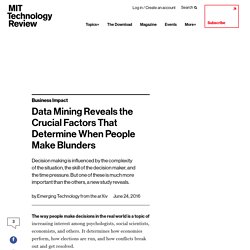
Your First Thought Is Rarely Your Best Thought: Lessons on Thinking. The Inner Path to Clear Thinking: Thoughts from a CIA Veteran. Love him or hate him, there’s little doubt that Warren Buffett is a master of decision-making.

Some might assume the keys to Buffett’s success are his skills in research or his intelligence, but Buffett says that’s not the case. In the introduction to The Intelligent Investor, he writes: “To invest successfully over a lifetime does not require a stratospheric IQ, unusual business insights, or inside information. What’s needed is a sound intellectual framework for making decisions and the ability to keep emotions from corroding that framework.” Countering the Inside View and Making Better Decisions. The 10/10/10 Rule For Tough Decisions. This Is the Most Important Fallacy You’ve Never Heard Of. One of the fathers of modern computing used this 6-step process to solve any problem.
"Genius is rarely able to give an account of its own processes," the philosopher George Henry Lewes once observed.
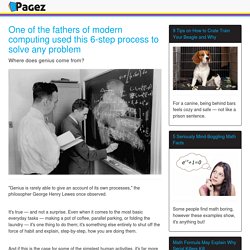
It's true — and not a surprise. Even when it comes to the most basic everyday tasks — making a pot of coffee, parallel parking, or folding the laundry — it's one thing to do them; it's something else entirely to shut off the force of habit and explain, step-by-step, how you are doing them. Ten Commandments for Aspiring Superforecasters. Creating Simple Rules for Complex Decisions. Executive Summary Machines can now beat humans at complex tasks that seem tailored to the strengths of the human mind, including poker, the game of Go, and visual recognition.
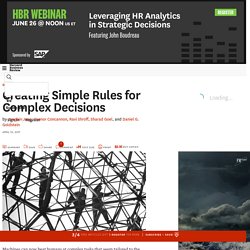
Yet for many high-stakes decisions that are natural candidates for automated reasoning—like those made by doctors diagnosing patients and judges setting bail—experts often favor experience and intuition over data and statistics. A simple, three-step procedure can help managers create rubrics that improve yes-or-no decisions. These rubrics can help judges decide whom to detain, tax auditors whom to scrutinize, and hiring managers whom to interview. Their approach offers practitioners the performance of state-of-the-art machine learning while stripping away needless complexity. Machines can now beat humans at complex tasks that seem tailored to the strengths of the human mind, including poker, the game of Go, and visual recognition. To see these rules in action, consider pretrial release decisions. Outsmart Your Own Biases.
Executive Summary When making decisions, we all rely too heavily on intuition and use flawed reasoning sometimes.
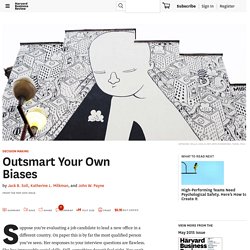
But it’s possible to fight these pernicious sources of bias by learning to spot them and using the techniques presented in this article, gleaned from the latest research. They’ll open up your thinking about possible outcomes, objectives, and options and lead to better choices. Implementation Intentions Facilitate Action Control. What Matters More in Decisions: Analysis or Process? Think of the last major decision your company made.

Maybe it was an acquisition, a large purchase, or perhaps it was whether to launch a new product. Odds are three things went into that decision: (1) It probably relied on the insights of a few key executives; (2) it involved some sort of fact gathering and analysis; and (3) it was likely enveloped in some sort of decision process—whether formal or informal—that translated the analysis into a decision. Now how would you rate the quality of your organization’s strategic decisions? If you’re like most executives, the answer wouldn’t be positive: In a recent McKinsey Quarterly survey of 2,207 executives, only 28 percent said that the quality of strategic decisions in their companies was generally good, 60 percent thought that bad decisions were about as frequent as good ones, and the remaining 12 percent thought good decisions were altogether infrequent.
How could it be otherwise? Product launches are frequently behind schedule and over budget. Speed as a Habit. This article is by Dave Girouard, CEO of personal finance startup Upstart, and former President of Google Enterprise Apps.
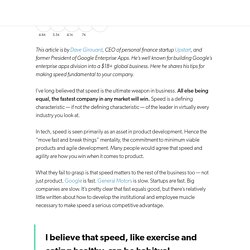
He’s well known for building Google’s enterprise apps division into a $1B+ global business. Daniel Kahneman’s Strategy for How Your Firm Can Think Smarter. Nobel economics laureate and psychologist Daniel Kahneman — considered the father of behavioral economics – retired from his teaching position at Princeton a few years ago to co-found a consulting firm in New York.

In a talk at the recent Wharton People Analytics Conference, he said of his consulting experience that he had “expected to be awed” by the quality of the decision-making in organizations “that need to make profits to survive in a competitive world.” Slow Deciders Make Better Strategists. There are many ways to split people into two groups. Young and old. Rich and poor. Re:Work - Guide: Adopt an analytics mindset. Many years back, Google experimented with 42 different shades of blue on the Google Toolbar to find which color would optimize click-through rates. Launching experiments and learning from the behavior of users to improve products is ingrained in Google's product development and business practices. Indeed, many organizations use this type of experimentation in their product development, customer engagement and business practices. The people analytics mindset is about instilling this type of data-driven approach in people issues.
This Is How To Make Good Decisions: 4 Secrets Backed By Research. Life would be a lot easier if we just knew how to make good decisions. Research shows we all make a lot of bad ones. With careers: More than half of teachers quit their jobs within four years. In fact, one study in Philadelphia schools found that a teacher was almost two times more likely to drop out than a student. Why We Are Better At Making Decisions For Other People. If you’ve ever started a sentence with, "If I were you . . . " or found yourself scratching your head at a colleague’s agony over a decision when the answer is crystal-clear, there’s a scientific reason behind it. Our own decision-making abilities can become depleted over the course of the day causing indecision or poor choices, but choosing on behalf of someone else is an enjoyable task that doesn’t suffer the same pitfalls, according to a study published in Social Psychology and Personality Science.
The 30 Percent Rule and the Art of Early Feedback. Let Your Values Drive Your Choices. Nearly every problem you face is temporary. But these temporary problems cause immediate pain. Understanding the Pareto Principle (The 80/20 Rule) Surprising Secret to Time Management. Achieve More With Less In Life Using 80/20 Principle. How to Make Good Decisions ... Faster. Follow Your Gut and Make Better Decisions with This Simple Test — lifehacker. The #1 Secret Astronauts, Samurai, Navy SEALs, and Psychopaths Can Teach You About Good Decision Making.
Decision Making - Start Here! - Financial, Business and Management Decision-Making Skills Training from MindTools. Making the Best Possible Choices. Tools for Decision Analysis. Tools for Decision Analysis:Analysis of Risky Decisions Para mis visitantes del mundo de habla hispana, este sitio se encuentra disponible en español en: Sitio Espejo para América Latina Sitio en los E.E.U.U.Making decisions is certainly the most important task of a manager and it is often a very difficult one. Decision Maker. How to use The grid lets you enter options (things you'll choose between) in columns. Just click the "add option" button, and enter the name of each option. Then you need to enter criteria that you want to rate your options on, like price, quality, frequency etc. Click the "add criteria" button and name your criteria.
The Checklist Manifesto: How to Get Things Right. Decisions Under Uncertainty. 7 talks on how we make choices. How To Win The Impulse War Inside Your Brain.